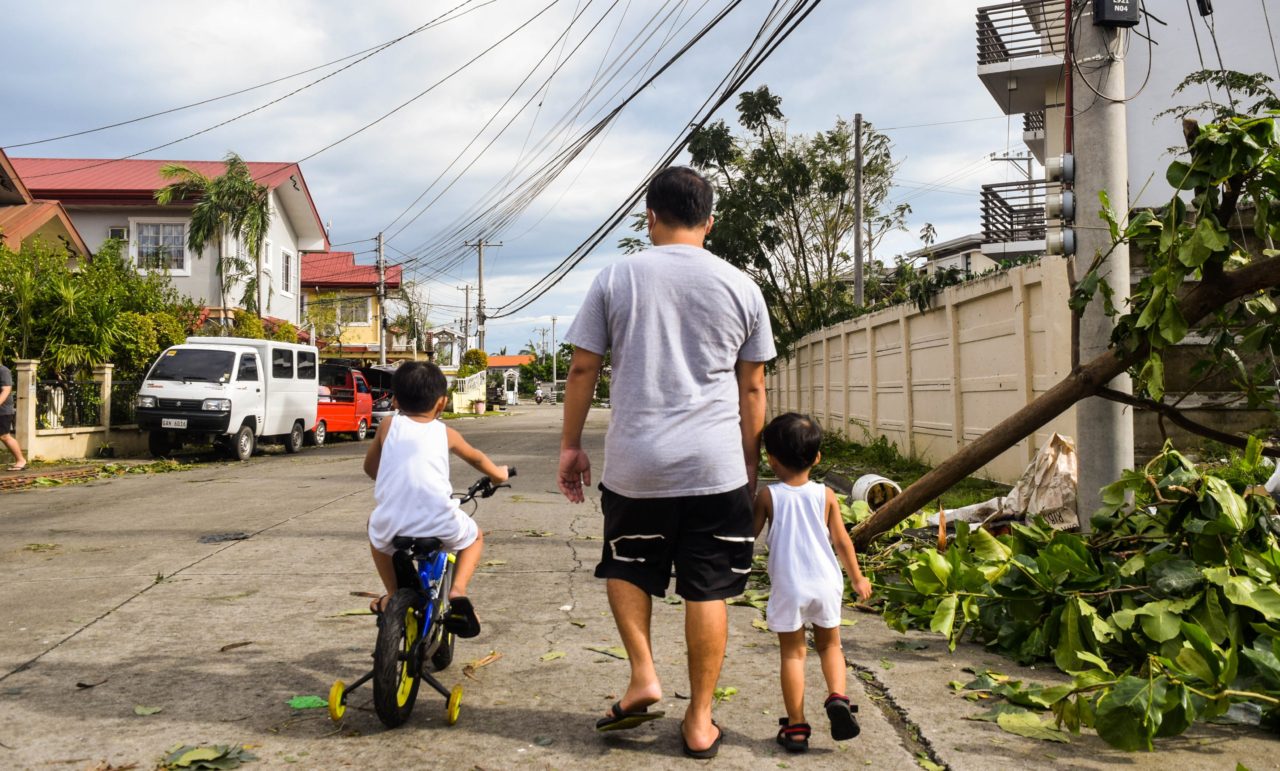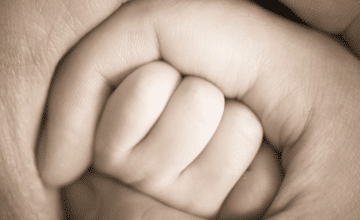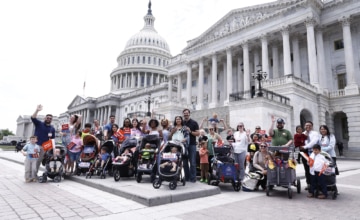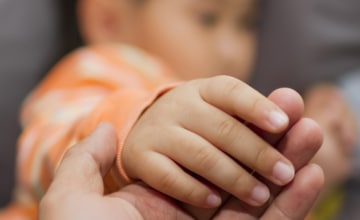Shelly L. Counsell and Judith A. Rosenberg, University of Memphis

Abstract
This article examines the family dynamics of older siblings caring for younger siblings (which may have increased during the current pandemic) and the potential impact on learning, development, and overall well-being for both the young child and young caregiver. The demands of caring for young children may be challenging to meet for child caregivers who are innately immature and lack developmental understanding of the needs of their infant/toddler charges. The article explores those demands, including forming attachments, satisfying their wants and needs, and healthy interactions. The effects of young caregiving on the psychosocial and academic development of younger children and the extent of impact on health care delivery are dire, yet remain largely unknown.
In December 2019, the earliest COVID cases were first identified in China and the virus reached the United States and other countries around the globe in early January 2020 (Kim et al., 2020; Wang et al., 2020). Children of all ages were directly impacted when COVID-19 cases spread throughout the US. Emerging epicenters in heavily populated communities with diverse populations (including Chicago, Detroit, Los Angeles, New Orleans, New York City, and Seattle) often experienced financial disparities and limited access to educational and medical resources. Among reported data, African-Americans (and people of color) are over-represented in the number of fatalities to date (Kirby, 2020; Shonkoff & Williams, 2020; Yancy, 2020).
As a result of the pandemic, resources that were already limited are now unavailable to many of the same families and children, due in part to the loss of income as a result of unemployment, protracted illness, or family death. Educational resources (e.g., public preschool programs, early childhood education (ECE) centers, church and hospital ECE programs, Head Start, home-based ECE programs, afterschool programs, children’s museums, zoos, camps, public libraries, and community centers) are no longer available and may never recover or return, with potentially catastrophic outcomes (Brooks et al., 2020; Center for the Study of Child Care Employment [CSCCE], 2020; Clark et al., 2020; Nguyen et al., 2020).
While the coronavirus pandemic has shut down much of the U.S. economy, with more than 33 million workers applying for unemployment insurance since March 15, 2020, millions of workers remained on the job providing essential services. Nearly every state governor issued executive orders that outline industries deemed “essential” during the pandemic, which typically include health care, food service, and public transportation, among others. In addition to health care workers and various support staff (e.g., hospital housekeeping personnel) individuals with lower paying jobs such as grocery store employees, sanitation workers, transit workers, public safety (police, fire, paramedics), filling station employees, and the like are equally essential (Blau et al., 2020; Chaganti et al., 2020; Chowkwanyun & Reef, 2020; Kinder, 2020). Many of these essential workers are women of color, lack a college degree, and cannot work remotely.
Despite being categorized as essential, many workers in these industries are not receiving the most basic health and safety measures to combat the spread of the coronavirus (Kerwin & Warren, 2020). Essential workers are dying as a result. When the Trump administration failed to provide essential workers basic protections, working people began taking action (Sim, 2020). Some essential workers walked off the job in protest over unsafe conditions and demanded personal protective equipment while unions fought to ensure workers received adequate workplace protections.
For the female essential worker (see Table 1) who has young children (McNicholas & Poydock, 2020), staying at home to care for her own children and retaining her employment are mutually exclusive. These essential workers shoulder the major responsibilities of feeding their families (North, 2020a; North, 2020b). ECE, whether for younger children or school-aged children, largely shut down in response to the pandemic. These closures further magnified and exacerbated an already existing ECE crisis nationwide.
Table 1. Female Employee Percentages in Essential Jobs
Individuals who have adult family members living in the same household (who can help provide care ) are minimally affected. Individuals who have adult family members residing in the same community, and who are able to break social distancing to provide assistance, are similarly unaffected. But individuals who do not have anyone to call on are most severely affected. Who will look after their children? A distinct possibility for many parents may be that an older child in the household must assume responsibility for caring for younger siblings (Rosenthal & Thompson, 2020).
Most Dire Consequences Shouldered by the Most Vulnerable
What is abundantly clear is that the effects of the pandemic are unevenly distributed. Children are affected in different ways and to different degrees than adults. Populations are affected differently depending on geography and socioeconomic conditions. New adverse effects continue to declare themselves as the pandemic continues to spread and evolve. According to Rosenthal and Thompson (2020), risk factors such as social isolation, school closures, and elevated stressors due to job loss make children more vulnerable to child abuse and neglect. Discrepant access to educational opportunity, health care, and mental health services has been present long before the COVID-19 pandemic, but these discrepancies are exponentially magnified by the effects of the pandemic (Golberstein et al., 2020; Laurencin, & McClinton, 2020; Rodgers et al., 2020).

Nearly every state governor issued executive orders that outline industries deemed “essential” during the pandemic, which typically include health care, food service, and public transportation, among others. Photo: pixfly/shutterstock
The same parents who struggle with securing affordable, high-quality ECE for their children now have similar difficulties with maintaining their school-age children’s access to daily educational instruction provided online (Shonkoff & Williams, 2020). Clearly, children who reside in households wherein there are no adults who have the time and/or educational foundation to provide educational assistance at home, or whose homes lack effective digital technology, are at a greater disadvantage compared to children who reside in homes with adults who can assist them and with adequate digital technology available. Without access to school however, the disadvantage gap becomes nearly infinite as children in high-need communities are left with virtually no educational resources. For many children, school is also the place where various forms of health care and mental health services are accessible, further threatening children’s wellness and well-being as a result of the pandemic (Bartlett et al., 2020; Schulman, 2020; Shonkoff & Williams, 2020).
ECE in Crisis
Prior to the COVID-19 pandemic, parents were already struggling to locate and place their children in quality ECE settings nationwide (North, 2020a, 2020b; Schulman, 2020). In Memphis (where both authors reside), the ongoing ECE crisis largely mirrors the same nationwide trends with 43% of parents reporting difficulties with finding ECE that is high quality; 54% of parents struggling with affordability; and 59% experiencing difficulties with accessibility (time slots that accommodate work schedules). As a result, two thirds of Memphis parents cobble together multiple arrangements and rely on informal and often unlicensed care, with 45% relying on family members for at least part of the time (Tennesseans for Quality Early Education, 2019). Similar to preschoolers living in poverty in Memphis and nationwide, affordable, high-quality ECE is beyond the reach of many of the 62% of working mothers with infants (Bureau of Labor Statistics, 2019). Despite this economic hardship, a mere 4.2% of low- and moderate-income families with babies and toddlers receive assistance with paying for care (Keating et al., 2019).
Socioeconomic Hardship for Parents
Prior to the COVID-19 pandemic, nearly 15 million children in the US were reported to be enrolled in programs that allow parents essential flexibility with their work schedules and careers (National Center for Education Statistics, 2016). As parents gradually returned to the workplace, many professionals, researchers, and advocates in ECE (CSCCE, 2020; Jones-Taylor, 2020) have sounded the alarm that without desperately needed support from Congress, ECE providers nationwide will be forced to permanently close their doors. Concerns of long-term effects impacting low-income young children (Dooley et al., 2020) should raise concerns among Congress, child health practitioners, educators, and advocates.
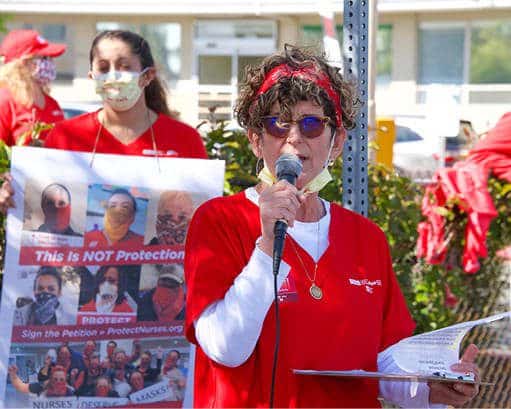
Some essential workers walked off the job in protest over unsafe conditions and demanded personal protective equipment while unions fought to ensure workers received adequate workplace protections. Photo: Sheila Fitzgerald/shutterstock
Without ECE centers and home child care providers, parents with infants and toddlers are forced to leave the workforce to stay at home to care for their children, with devastating consequences for their economic security (Bartlett et al., 2020; Esposito & Principi, 2020). Closings further impact the economic security of the early childhood educators and caregivers who will lose their jobs and medical benefits. While experts and advocates have recommended Congress designate $50 billion through the Child Care and Development Block Grant, only $3.5 billion (just 7%) of the recommended provision has been allocated.
Developmental Concerns for Young Children Living in Poverty
Research in the US (and other economically stratified countries) has demonstrated that young children from lower socioeconomic status homes frequently test lower on measures of cognitive and language skills (Christensen et al., 2014) and even worse on intelligence tests, although it is important to note that those tests are highly biased against historically marginalized groups that include lower socioeconomic status, dual language learners, and minorities (particularly African-American males). Children who perform poorly on standardized assessments often exhibit diminished executive functioning (Sarsour et al., 2011) that further impedes their readiness for formalized education (Garcia, 2015). Inadequate cognitive stimulation is one of four key risk factors (in addition to stunting, iron deficiency, and iodine deficiency) preventing children from reaching their potential in developing countries (Walker et al., 2007). This research serves to further demonstrate the urgent need to ensure every child has equal access to high-quality ECE and supervision for both younger and older siblings alike.
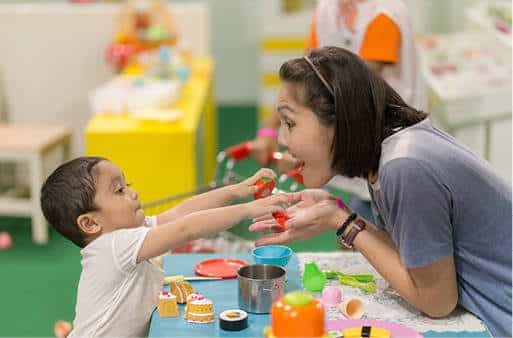
Language and literacy-rich environments actively encourage ongoing, engaging interactions among adults and children. Photo: SONGPAN JANTHONG/shutterstock
Because language development (and a strong literacy foundation) begins at birth, studies clearly point to the growing child’s brain “architecture” and how early life experiences, authentic contexts, and educational settings influence ongoing brain development (Center on the Developing Child at Harvard University, 2016; Children’s Bureau, 2016; Jacoby & Lesaux, 2014; Lesaux, 2010). Exposure to high-quality language experiences at 3 years old is a strong predictor of 10th grade reading achievement (Snow et al., 2007). Language- and literacy-rich environments actively encourage ongoing, engaging interactions among adults and children (birth to 9 years old) in which young children ask questions, initiate conversations, tell stories, recite finger plays, and sing songs; quality interactions that further promote strong and healthy bonds and attachment (Baker-Henningham & Boo, 2015). These kinds of adult–child interactions set expectations that we argue may be too developmentally demanding for many older siblings (particularly children 7–12 years old) and can lead to increased stress and anxiety for older siblings that can be counter-productive to their own learning and development not to mention, may cause potential bitterness and resentment toward their younger sibling.
Socioeconomic Hardship for ECE Professionals
Despite the key role that ECE providers play in the long-term economy recovery, the ECE system as a whole is on the brink of collapse due to the economic downturn, racial/ethnic inequities, and disparities in health and education (Cluver et al., 2020; Williams & Cooper, 2020). Private ECE centers and home child care providers, like other small business owners, are faced with many of the same economic perils in relation to (1) ensuring the physical health and safety of both employees and the children and families they serve, (2) dwindling enrollment and income (because parents are choosing to keep their children home or they can no longer afford to pay for care due to a loss in income), and (3) the economic burden of limited or unaffordable essential supplies (e.g., masks, gloves, and disinfectant cleaning materials). According to Bartlett, Griffin, and Thomson (2020), the supportive resourses needed will provide stability and environmental security for the developmental well-being of children and families impacted by COVID-19.
In California alone, a brief survey of more than 2,000 licensed ECE centers and licensed family child care programs conducted by CSCCE revealed that 66% of programs said families are unable to pay or have lost their jobs or income and as a result, 61% of the programs have endured a loss of income due to declines in attendance and families’ inability to pay. The economic downturn has further resulted in 78% of programs making staffing changes (e.g., laid off staff, reduced benefits) and 57% of all programs either laid off or furloughed staff. Among programs that remained open, 62% struggled to obtain either cleaning or sanitizing supplies or personal protective equipment for staff and 69% would like mini-grants to pay for cleaning supplies and/or sanitizing services. Without low-interest or forgivable loans or financial resources to cover operating and staff costs during closures, 63% of open programs would not survive a closure of 1 month or longer; 23% would not survive a closure of any length of time; and 14% of already-closed programs reported that they would not survive the closure past the end of the month in which the survey was taken (CSCCE, 2020).
When Will We Care About the Children?
Mothers and other adult female family members have traditionally cared for their young children, elderly parents, or family members with a chronic or debilitating condition. The majority of paid family caregivers (60%) are female. Women’s increased financial contribution to household incomes through outside employment (National Academies of Sciences Engineering and Medicine, 2016; National Alliance for Caregiving & AARP Public Policy Institute, 2015) has shifted child care to family members or paid ECE programs. Almost 20 years ago, the Children’s Defense Fund (2003) noted that millions of children lacked safe, affordable, quality ECE while parents work. This research found 7.5 million children at home alone without supervision, often after school (a time period in which they are statistically at the greatest risk for injury or getting into trouble; Crockett, 2003). Children who are most vulnerable to receiving inadequate ECE and adult supervision belong to poor and extreme poverty households. In the US, the pandemic has had an effect on the ongoing continuum of care for young children, with adult supervision at one end and children in self-care arrangements at the opposing end. Along the continuum, children (often older siblings) help supervise their younger children in one room at home while a parent (often a mother) works in another room (such as the kitchen). Next along the continuum are children serving in the role as child caregivers in the absence of any adult. When will this matter? When will this change?
Children as Self-Care Providers
Self-care children are reportedly between 6 and 13 years old who spend time at home alone or with a younger sibling (Rodman et al., 1988). However, whether leaving a young child unsupervised is considered neglect (especially if being left alone places the child in danger) depends on the laws and child protective policies where the parents reside. Today, only three states currently have minimum age laws for leaving a child home alone: Illinois (14 years old), Oregon (10 years old), and Maryland (8 years old). While child protection laws generally define child neglect as “failing to provide adequate supervision of a child,” states do not generally elaborate on what is considered “adequate supervision” (Child Welfare Information Gateway, 2018, p. 2).
Children in self-care are more likely to engage in risky behavior, suffer injuries, or experience depression (Ruiz-Casares et al., 2012). School work and family responsibilities in addition to experiences with loneliness, boredom, fear, and social isolation are familiar trends that have increased during the pandemic (Bradbury-Jones, & Isham, 2020). Among children in self-care arrangements, boys experience higher injury death rates that are almost 2 times the rate for girls. Boys have a higher death rate across all childhood age groups. For children less than 1 year old, two thirds of injury deaths were due to suffocation, while drowning was the leading cause of injury death for children 1 to 4 years old (Ruiz-Casares et al., 2012). What remains largely unreported is whether injury deaths occurred while children were left home alone in self-care, children were under the supervision of older siblings, or older siblings were the primary caregiver.
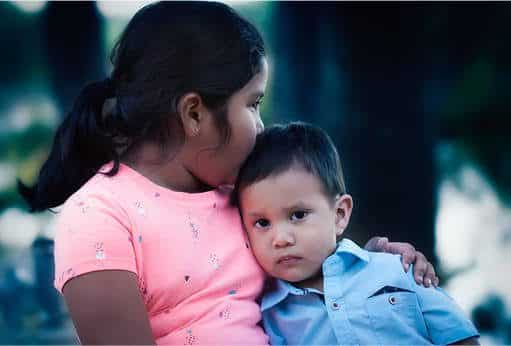
Overall, the well-being of younger children largely depends on the adequacy of supervision and caregiving provided, whether by an adult or older sibling. Photo: Marlon Lopez MMG1 Design/shutterstock
Sibling Supervisors or Sibling Caregivers
Generally, sibling supervision has been conceptualized broadly to include “independent full-time care” to simply “keeping an eye” on a younger sibling in the parent’s absence (Weisner & Gallimore, 1977). During the current pandemic, according to Katz and Cohen (2020), siblings serving as caregivers will most likely take place when an older sibling fully cares for younger siblings while parents (many of whom are single and essential workers) are at work. This situation in particular may render children at risk for neglect without voice and agency. In light of regional and state age laws designed to regulate when children can be left alone without adult supervision, it is difficult to estimate how often children are left alone if parents fear admitting they have left their children unsupervised by an adult may be considered just cause for neglect.
Developmental Ramifications for Sibling Caregivers and the Siblings Under Their Care
Overall, the well-being of younger children largely depends on the adequacy of supervision and caregiving provided, whether by an adult or older sibling. Certainly, the quality of supervision and caregiving by older siblings in contrast to adults is a central concern, both for the sibling caregiver and the younger sibling (Kurdick & Fine, 1995). However, the well-being of the older sibling is largely overlooked and, we argue, must likewise be considered because in older sibling supervision and caregiving contexts, both children are without adequate adult caregiving and supervision.
To date, research examining sibling supervision contexts has suggested that older siblings lack adequate judgment needed to ensure the younger siblings’ well-being (Nathans et al., 2000). Similarly, sibling caregivers (7–12 years old) often lack the cognitive skills needed to problem solve and resolve conflicts experienced with demanding younger siblings, more often resorting to physically punitive measures and verbal scolding (Bryant, 1989).
Along with developmental issues and concerns, researchers have raised concerns regarding the increased risk of injury when young children are supervised or cared for by older siblings. In one sample of toddler deaths, Rauchschwalbe, Brenner, and Smith (1997) determined that 11 out of 32 deaths (35%) occurred when an older sibling was present in the bathtub and the parent was not present. It has been reported that older siblings use fewer proactive safety strategies and younger siblings engage in more risk-taking behaviors with older siblings while older siblings visually attend to risk-taking behaviors less often than mothers (Morrongiello et al., 2007). As a result, it appears that the frequency of sibling supervision correlates with an increased risk for younger sibling injuries (Borse et al., 2008; Schell et al., 2015).
In an effort to counter this alarming trend by eliminating the risk of injury of young siblings under the supervision or care of older siblings, Schell, Morrongiello, and Pogrebtsova (2015) created an online training program, Safe Sibs, together with a software development company for older children (7–11 years old) and their younger siblings (2–5 years old). This training program includes four training modules: (1) The Problem of Child Injury and Role of Child Development; (2) Identifying, Finding, and Managing Hazards; (3) How to be a Good Supervisor; and (4) Dealing With Supervisee Noncompliance. While these authors concede that adult supervision is ideal, they suggest that this new program can increase older children’s knowledge of child development and supervisory skills. However, there can be a wide range of development and maturation across the 7–11 year age range and hence, whether these kinds of expectations are developmentally appropriate should be called into question, not to mention the negative consequences for development (e.g., increased depression) and schooling (e.g., absenteeism) for older siblings (Yi et al., 2012).
Conclusion
Failure to address the resulting ECE gap, as magnified by COVID-19, will most certainly continue to remain a key contributing factor in the academic achievement and life outcome gaps for children and families in marginalized communities in this country and worldwide. Parents with fewer resources must rely on their older children, who are developmentally unable to provide rich learning experiences needed to enhance their younger siblings’ school readiness. Rather than create interventions such as Safe Sibs, we recommend creating greater access to high-quality ECE for all families to help maximize children’s cognitive and social–emotional development and increase the likelihood that they will perform better in school and in the eventual labor market (Auger et al., 2014; Barnett et al., 2013; Campbell et al., 2014; Gathmann & Sass, 2018; Gormley et al., 2018).
In this article, we have outlined the developmental and wellness issues and concerns related to sibling caregivers and their younger siblings, which reveal a wide continuum of care and supervision. The current pandemic has further exposed and exacerbated the existing disparities and structural barriers to securing adequate care for young children and their families. The majority of research prior to the pandemic has focused on young children’s risk-taking behaviors and resulting unintentional injuries (and death) and subsequent wellness and developmental consequences that occur while younger siblings are either supervised or cared for by an older sibling (often 7–12 years old).
What is frequently overlooked in this running narrative is the potentially negative impact on development and wellness for the older sibling. When parents create or are forced into contexts (like the current pandemic) that place supervisory or caregiving expectations onto older siblings, the tendency to lose sight of older siblings as “children” who still need to be nurtured developmentally and whose wellness is a continued priority increases. Instead, older siblings are now viewed as helpers who are expected to supervise, care for, and nurture the development and wellness of their younger siblings in their charge that is arguably at their own developmental expense. Sadly, this scenario, heightened by the pandemic, compromises the potential development for older and younger siblings. It took a pandemic to shine a spotlight on the longstanding inequities facing young children and their families. What will it now take to ultimately resolve the ECE crisis?
Author Bios
Shelly L. Counsell, EdD, is an associate professor in early childhood education in the College of Education at the University of Memphis and teaches undergraduate and graduate early childhood courses. She formerly taught in the early childhood blended certificate program at Idaho State University. Dr. Counsell studied early childhood constructivist education under Dr. Rheta DeVries and earned her doctorate at the University of Northern Iowa (UNI). As a research fellow at UNI, she helped develop early physical science teacher workshops. Dr. Counsell’s early childhood research topics and interests include Head Start, Special Olympics, inclusion, diversity, constructivism, inquiry, early STEM teaching and learning, high-stakes testing, and social justice. She has has taught in public schools at the pre-K, elementary, and secondary levels in California, Florida, Ilinois, and Wisconsin, and she has published articles, book chapters, and books on topics in early childhood, early STEM, and special education as well as presented at national and international conferences.
Judith A. Rosenberg, PhD, MPH, PNP, is a recently retired assistant professor at the University of Memphis Loewenberg College of Nursing. She currently continues to do research in affiliation with the Society of Pediatric Nursing. Dr. Rosenberg has spent the bulk of her career as a primary care pediatric nurse practitioner, and her practice focused on populations of children who are chronically underserved by existing health care establishments. This has included children of migrant agricultural workers, children in the custody of the juvenile justice system, and children who are the victims of maltreatment. In recent years, Dr. Rosenberg, whose doctorate is in the field of applied anthropology, has moved into nursing education, and has taught at the University of Florida, Florida Southern College, The University of Tampa, and the University of Memphis. Her current research interest is children who function as caregivers for family members who are incapable of completely performing their own activities of daily living self-care.
Suggested Citation
Counsell, S. L., & Rosenberg, J. A. (2021). The plight of children caring for children during the COVID-19 pandemic: The learning and developmental consequences. ZERO TO THREE Journal, 41(Supp.).
References
Auger, E., Farkas, G., Burchinal, M. R., Duncan, G., & Vandell, D. (2014). Preschool center care quality effects on academic achievement: An instrumental variables analysis. Developmental Psychology, 50, 2559–2571.
Baker-Henningham, H., & Boo, F. L. (2010). Early childhood stimulation interventions in developing countries: A comprehensive literature review. (Discussion Paper IZA DP No. 5282). link
Bartlett, J. D., Griffin, J., & Thomson, D. (2020, March 19). Resources for supporting children’s emotional well-being during the COVID-19 pandemic. Child Trends. link
Barnett, S. W., Jung, K., Youn, M., & Frede, E. (2013). Abbott preschool program longitudinal effects study: Fifth grade follow-up. National Institute for Early Educational Research. link
Blau, F. D., Koebe, J., & Meyerhofer, P. A. (2020). Who are the essential and frontline workers? DIW Discussion Papers, No. 1893. Deutsches Institut fur Wirthschaftsforschung (DIW).
Borse, N. N., Gilchrist, J., Dellinger, A. M., Rudd, R. A., Ballesteros, M. F., & Sleet, D. A. (2008). CDC childhood injury report: Patterns of unintentional injuries among 0-19 year olds in the United States, 2000-2006. Centers for Disease Control and Prevention, National Center for Injury Prevention and Control.
Bradbury-Jones, C., & Isham, L., (2020).The pandemic paradox: The consequences of COVID-19 on domestic violence. Journal of Clinical Nursing, 29(13–14), 2047–2049. link
Brooks, S., Webster, R. K., Smith, E. K., Woodland, L., Greenberg, N., & Rubin, G. J. (2020). The psychological impact pf quarantine and how to reduce it: Rapid review of evidence. Lancet, 395, 312–320.
Bryant, B. K. (1989). The child’s perspective of sibling caretaking and its relevance to understanding social-emotional functioning and development. In P. G. Zukow (Ed.), Sibling interaction across culture: Theoretical and methodological issues (pp. 143–164). Springer.
Bureau of Labor Statistics. (2019). Table 6. Employment status of mothers with children under 3 years old by single year of age of youngest child and marital status, 2017-2018 annual averages. U.S. Department of Labor. link
Campbell, F., Conti, G., Heckman, J. J., Moom, S. H., Pinto, R., Pungello, E., & Pan, Y. (2014). Early childhood investments substantially boost adult health. Science, 343(6178), 1478–1485.
Center on the Developing Child at Harvard University. (2016). Applying the science of child development in child welfare systems. link
Center for the Study of Child Care Employment (CSCCE). (2020). California child care at the brink. The devastating impact of COVID-19 on California child care. University of California, Berkeley Data Snapshot/May2020. cscce.berkeley.edu link
Chaganti, S., Graves, E., Higgins, A., Mattingly, M., Savage, S., & Tonsberg, C. (2020). The effcts of the novel coronovirus pandemic on service workers in New England. Issue Brief. link
Child Welfare Information Gateway. (2018). Leaving your child home alone. U.S. Department of Health and Human Services, Children’s Bureau. link
Children’s Bureau. (2016). Child maltreatment 2014, ii. U. S. Department of Health & Human Services, Administration for Children and Families, Administration on Children, Youth, and Families. link
Children’s Defense Fund. (2003). Key facts. link
Chowkwanyun, M., & Reef, A. (2020). Racial health disparities and COVID-19—Caution and context. New England Journal of Medicine, 383(3), 201–203.
Christensen, D. L., Schieve, L. A., Devine, O., & Drews-Botsch, C. (2014). Socioeconomic status, child enrichment factors, and cognitive performance among preschool-age children results from the Follow-Up of Growth and Development Experiences study. Research in Developmental Disabilities, 35(7), 1789–1801.
Clark, H., Coll-Seck, A. W., Banerjee, A., Peterson, S., Dalglish, S., et al. (2020), A future for the world’s children? AWHO-UNICEF-Lancet Commission. Lancet, 395, 605–658. link
Cluver, L., Lachman, J. M., Scherr, L., Wessels, I., Krug, E., Ralotomalala, S., Blight, S., Hillis, S., Bachman, G., Green, O., Butchart, A., Tomlinson, M., Ward, C., Doubt, J., & McDonald, K. (2020). Retrieved from Parenting in a time of COVID-19. Lancet. link
Crockett, D. (2003). Critical issues children face in the 2000s. School Psychology Quarterly, 18(4), 446–453.
Dooley, D. G., Bandealy, A., & Tschudy, M. M. (2020). Low-income children and coronavirus disease (COVID-19) in the US. JAMA Pediatrics, 174(10), 922–923. [link] (Doi.org/10.1001/jamapediatrics.2020.2065)
Esposito, S., & Principi, N. (2020). School closure during the coronavirus disease 2019 (COVID-19) pandemic: An effective intervention at the global level? JAMA Pediatrics, 174(10), 921–922. link
Garcia, E. (2015). Inequalities at the starting gate: Cognitive and noncognitive skills gaps between 2010-2011 kindergarten classmates. Economic Policy Institute.
Gathmann, C., & Sass, B. (2017). Taxing childcare: Effects on childcare choices, family labor supply, and children. Journal of Labor Economics, 36(3), 665–709. link
Golberstein, E., Wen, H., & Miller, B. (2020). Coronovirus disease 2019 (COVID-19) and mental health for children and adolescents. JAMA Pediatrics, 174(9), 819–820. link
Gormley, W. T., Phillips, D., & Anderson, S. (2018). The effects of Tulsa’s Pre-K program on middle school student performance. Journal of Policy Analysis and Management, 37(1), 63–87.
Jacoby, J. W., & Lesaux, N. K. (2014). Support for extended discourse in teacher talk with linguistically diverse preschoolers. Early Education and Development, 25(8), 1162–1179.
Jones-Taylor, M. (2020, April 14). Will the virus kill American child care? Centers across America need help desperately. New York Daily News link
Katz, C., & Cohen, C. (2020). Invisible children and non-essential workers: Child protection during COVID-19 in Israel according to policy documents and media coverage. Child Abuse and Neglect, 116, 104770. link
Keating, K., Daily, S., Cole, P., Murphey, D., Pina, G., Ryberg, R., Moron, L., & Laurore, J. (2019). State of babies yearbook 2019. ZERO TO THREE and Child Trends.
Kerwin, D., & Warren, R. (2020). US foreign-born workers in the global pandemic: Essential and marginalized. Journal on Migration and Human Security, 8(3), 282–300. link
Kim, L., Whitaker, M., O’Halloran, A., Kambhampati, A., Chai, C. J., Reingold, A., Armistead, I., Kawasaki, B., Meek, J., Yousey-Hines, K., Anderson, E. J., Openo, K. P., Weigel, A., Ryan, P., Monroe, M. L., Fox, K., Kim, S., Lynfield, R., Bye, E., Davis, S. S., …COVID-NET Surveillance Team. (2020). Hospitalization rates and characteristics of children aged <18 years hospitalized with laboratory confirmed COVID-19—COVID-NET 14 States, March 1–July 25, 2020, Morbidity and Mortality Weekly Report, 69(32), 1081–1089.
Kinder, M. (2020). Essential but undervalued: Millions of healthcare workers aren’t getting the pay or respect they deserve in the COVID-19 pandemic. Brookings. link
Kirby, T. (2020). Evidence mounts on the disproportionate effect of COVID-19 on ethnic minorities. Lancet Respiratory Medicine, 8(6), 547–548. link
Kurdick, L. A., & Fine, M. A. (1995). Mothers, fathers, stepfathers and siblings as providers of supervision, acceptance, and autonomy granting to young adolescents. Journal of Family Psychology, 9, 95–99.
Laurencin, C., & McClinton, A. (2020). The COVID-19 pandemic: A call to action to identify and address racial and ethnic disparities. Journal of Racial and Ethnic Health Disparities, 7, 398–402. link
Lesaux, N. K. (2010). Turning the page: Refocusing Massachusetts for reading success. Strategies for Children, Inc.
McNicholas, C., & Poydock, M. (2020). Who are essential workers? Economic Policy Institute (EPI). link
Morrongiello, B. A., MacIsaac, T. J., & Klemencic, N. (2007). Older siblings as supervisors: Does this influence young children’s risk of unintentional injury? Social Science & Medicine, 64, 807–817.
Nathans, A. B., Neff, M., Goss, C. H., Maier, R. V., & Rivera, F. P. (2000). Effect of older sibling and birth interval on the risk of childhood injury. Injury Prevention, 6, 219–222.
National Academies of Sciences, Engineering, and Medicine. (2016). Older adults who need caregiving and the family caregivers who help them. In R. Schulz & J. Eden (Eds.), Families caring for an aging America (pp. 43–70). The National Academies Press.
National Alliance for Caregiving, & AARP Public Policy Institute. (2015). Caregiving in the United States. 2015 report. link
National Center for Education Statistics. (2016). Early Childhood Participation Survey of the 2016 National Household Surveys Program (ECPP-NHES:2016). link
North, A., (2020a). The women’s work of the pandemic. Who sews the masks? How women are shouldering the burden pandemic preparedness. Vox. link
North, A., (2020b). “We are on our own” How the coronavirus pandemic is hurting child care workers. Vox. link
Nguyen, U. S., Smith, S., & Granja, M.R. (2020). Young children in deep poverty: Racial/ethnic disparities and child well-being compared to other income groups. National Center For Children In Poverty, Bank Street Graduate School of Education.
Rauchschwalbe, R., Brenner, R. A., & Smith, G. S. (1997). The role of bathtub seats and rings in infant drowning deaths. Pediatrics, 100, E1.
Rodgers, T. N., Rodgers, C. R., VanSant-Webb, E., Gu, L., Yan, B., & Qeadan, F. (2020). Racial disparities in COVID-19 mortality among essential workers in the United States. World Medical and Health Policy, 12(3), 311–327. link
Rodman, H., Pratto, D. J., & Nelson, R. S. (1988). Toward a definition of self-care children: A commentary on Steinberg (1986). Developmental Psychology, 24(2), 292–294.
Rosenthal, C. M., & Thompson, L. A. (2020). Child Abuse Awareness Month during the coronavirus disease 2019 pandemic. JAMA Pediatrics, 174(8), 812. link
Ruiz-Casares, M., Rousseau, C., Currie, J. L., & Heymann, J. (2012). “I hold on to my teddy bear really tight:” Children’s experiences when they are home alone. American Journal of Orthopsychiatry, 82(1), 97–103.
Sarsour, K., Sheridan, M., Jutte, D., Nuru-Jeter, A., Hinshaw, S., & Boyce, W. T. (2011). Family socioeconomic status and child executive functions: The roles of language, home environment, and single parenthood. Journal of International Neuropsychological Society, 17(1), 120–132.
Schell, S. L., Morrongiello, B. A., & Pogrebtsova, E. (2015). Training older siblings to be better supervisors: An RCT evaluating the “Safe Sibs” program. Journal of Pediatric Psychology, 40(8), 756–767.
Schulman, K. (2020). Child care’s struggle to survive COVID-19: State impacts And responses. link
Shonkoff, J. P., & Williams, D. R. (2020). Thinking about racial disparities in COVID-19 impacts through a science-informed early childhood lens. link
Sim, M. R. (2020). The COVID-19 pandemic: Major risks to healthcare and other workers on The front line. Occupational & Environmental Medicine, 77, 281–282.
Snow, C. E., Porsche, M. V., Tabors, P. O., & Harris, S. R. (2007). Is literacy enough? Pathways to academic success for adolescents. Brookes.
Tennesseans for Quality Early Education. (2019). Want to grow Tennessee’s economy? Fix the child care crisis (Memphis Edition). Report at TQEE.org. link
Walker, S. P., Wachs, T. D., Gardner, J. M., Lozoff, B., Wasserman, G. A., Pollitt, E., & Carter, J. A. (2007). Child development: Risk factors for adverse outcomes in developing countries. Lancet, 369(9556), 145–157. link
Wang, G., Zhang, Y., Zhao, J., Zhang, J., & Jiang, F. (2020). Mitigate the effects of home confinement on children during the COVID-19 outbreak. Lancet, 395, 945–947.
Weisner, T. S., & Gallimore, R. (1977). My brother’s keeper: Child and sibling caretaking. Current Anthropology, 18, 169–190.
Williams, D. R., & Cooper, L. A. (2020). COVID-19 and health equity: A new kind of “herd immunity”. JAMA, 323(24), 2478–2479. link
Yancy, C.W. (2020). COVID-19 and African Americans. JAMA, 323(19), 1891–1892. link
Yi, S., Poudel, K. C., Yasuoka, J., Palmer, P. H., Yi, S., Yanagisawa, S., & Jimba, M. (2012). Sibling care, school performance, and depression among adolescent caretakers in Cambodia. Asian Journal of Psychiatry, 5, 132–136.

